Contents
Market Overview
Macro Review
The ECB opted not to taper. The Bank of Canada and the Bank of England have already begun tapering, indeed the latter signaled a possible hike in 2022. This effectively raised the stakes for the Federal Reserve as the next FOMC looms and the market is left wanting more clarity on tapering, especially after a toppy inflation release. U.S. CPI came in at 0.6% m/m, exceeding expectations and rose to 5% y/y, which is the largest annual gain since 2008. The narrative around whether inflation is transitory is broadly unchanged, at least as swap markets tightened and 10yr UST yields dipped below 1.50%. Meanwhile Chinese PPI hit 9% y/y for May, recording the highest print in 15 years as the global inflation phenomena dominates headlines. However, during a quiet week, volatility was relatively subdued. Commodities were roughly flat with minor weakness in copper and steel offset by gains in gold and silver. Despite an algo-led dip mid-day Thursday, oil prices were stronger this week. As of Thursday, prices are above $70/bbl reinforcing the expected strength in summer demand. While U.S. data showed a build-up in refined products, U.S. production growth remains subdued underpinning OPEC’s undersupplied market.
EM Credit Update
EM credit gained 0.7% and tightened 2bps in spread. Suriname, El Salvador and Zambia underperformed while Argentina and Iraq outperformed.
The Week Ahead
The key focus next week will be the FOMC and ears will be tuned in to potential tapering commentary. Aside from Biden’s European tour and the NATO summit in Brussels (June 14), Biden will meet bilaterally with Erdogan and also Putin. Elsewhere, Chinese retail sales will be closely followed, where the market will look for 12% growth. Industrial production is also expected to moderate, albeit to a figure of c.9.2%. India’s headline inflation is expected to rise back above 5% as food prices begin to accelerate once again. We are also unlikely to see any major rate revisions, at least out of Indonesia (3.50%), Taiwan (1.125%) or Turkey (19.0%), but Ukraine may hike for a third time by 25bps to 8.0%. Current account data out of Turkey will also be watched, with the expectation of a narrower deficit, followed by a shrinking surplus in Poland.
Highlights from emerging markets discussed below include: Biden’s upcoming meetings with Putin and Erdogan, Peru’s very tight second round presidential election outcome, Mexico’s ruling coalition retains a simple majority in mid-term vote and Angola successfully completed its 5th review under its EFF program and received a $772mm disbursement.
Fixed Income
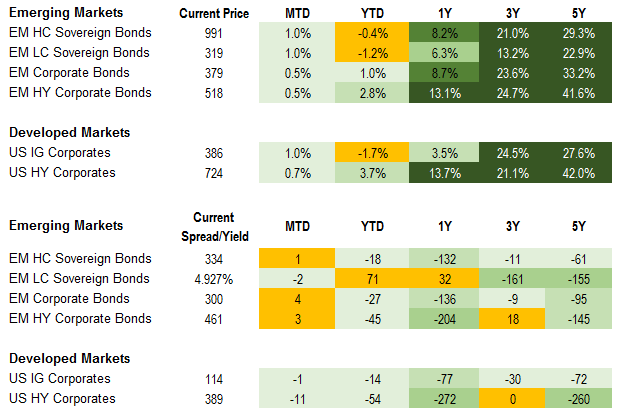
Equities
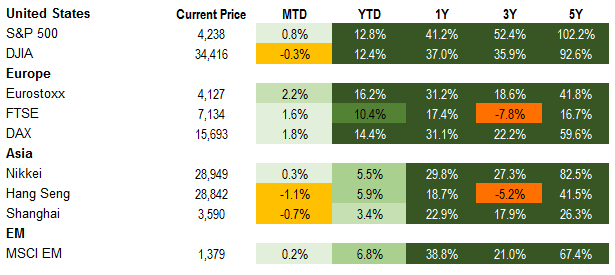
Commodities

Source for data tables: Bloomberg, JPMorgan, Gramercy. EM Fixed Income is represented by the following JPMorgan Indicies: EMBI Global, GBI-EM Global Diversified, CEMBI Broad Diversified and CEMBI Broad High Yield. DM Fixed Income is represented by the JPMorgan JULI Total Return Index and Domestic High Yield Index. Fixed Income, Equity and Commodity data is as of June 11, 2021 (Mid Afternoon).
Emerging Markets Weekly Highlights
Biden’s upcoming meetings with Putin and Erdogan unlikely to catalyze material easing of geopolitical risks for Russia and Turkey
Event: As part of his European tour, U.S. President Biden will hold bilateral talks with his Turkish counterpart Erdogan on the sidelines of the NATO summit in Brussels on June 14 and meet with Russian President Putin in Geneva on June 16.
Gramercy Commentary: When it comes to Russian and Turkish assets, geopolitical risks play a critical role in capital allocation decisions by global investors. As such, next week’s one-on-one meetings between the two countries’ leaders and President Biden are an intrinsically important event from a market perspective, given the U.S. tends to be the main source of geopolitical risk for both Russia and Turkey. Direct discussions at the highest political level tend to be constructive for reducing uncertainty, but we do not expect anything “game-changing” for Russia and Turkey to emerge from the Biden meetings. The main reason for our muted expectations is that we see a very limited scope for the two sides to “meet in the middle” on the key issues that plague their respective diplomatic relationships. In the case of U.S.-Russia relations, alleged persistent Russian cyber activity against a number of U.S. entities/institutions and U.S. sanctions against Russia stand out. For U.S.-Turkey relations the main tensions stem from Ankara’s purchases of advanced Russian weapon systems and the recent formal recognition by the Biden White House of the Armenian genocide by the Ottoman Empire in the early 20th century, which is a reading of historical events vehemently rejected by modern-day Turkey. In the case of both Russia and Turkey, the Biden Administration has expressed a number of strongly worded concerns regarding human rights abuses against political opponents of Presidents Putin and Erdogan. Turkey’s membership of and status within NATO (the second largest standing army of the Alliance and traditionally the key U.S. security partner in the Middle East) on one hand and the close relationship forged over the last few years between presidents Putin and Erdogan on the other, complicate things even further. In this highly complex and dynamic context, we expect a generally constructive tone to prevail, but no material changes to the existing tense geopolitical status quo involving the U.S., Russia and Turkey. If we are correct, what would a neutral (i.e. no positive/negative surprises) outcome mean for markets? Given strong fundamentals and macro tailwinds for Russia (e.g. higher commodities prices), we think that investors will interpret the lack of “bad news” from the Biden-Putin Geneva summit as good news, supporting the existing momentum to Russian assets. In the case of Turkey, domestic factors are far less supportive (e.g. outright headwinds) for market performance. As such, an external positive catalyst in the form of Biden-Erdogan rapprochement would be more meaningful for Turkish assets. However, such a scenario carries a low probability and any potential market relief would likely prove to be transitory, in our view.
Peru’s very tight second round presidential election outcome points to Castillo victory
Event: On Sunday, Peru held a run-off vote between radical leftist and outsider candidate, Pedro Castillo, and a well-known but corruption-tainted, center-right candidate, Keiko Fujimori. With nearly all votes counted, Castillo appears to have secured a narrow win with 50.2% of the vote. Pending review of a portion of votes may erode the difference, albeit carries a low probability of changing the outcome.
Gramercy Commentary: The impact is credit negative due to the high degree of polarization and uncertainty combined with likelihood for deterioration of policymaking and macroeconomic fundamentals over the medium-term. With that being said, remarks from Castillo and his advisors in the aftermath of the election point to an initial attempt to moderate and assuage concerns in the backdrop of a divided population. This combined with lack of congressional majority and a robust sovereign balance sheet has contributed to a relatively muted market reaction thus far. Assuming confirmation of a Castillo presidency and smooth transition of power, the market should focus on cabinet appointments, advisors, and further elaboration on the economic agenda. In our view, Castillo will not be able or willing to move as far to the center as Humala but his swift rise to the top and likely still somewhat undefined ideology leaves open the possibility for a pragmatic faction in the administration. In addition to the cabinet composition, the ultimate role and influence of the leader of the ruling Peru Libre party, Vladimir Cerron, as well as Castillo’s approach to the constitution, should be key determinants of the degree and pace of radicalization of policy.
Mexico’s ruling coalition retains a simple majority in mid-term vote; AMLO to cement legacy in second half of term
Event: The mid-term elections held on Sunday delivered the market anticipated outcome of loss of the ruling Morena coalition’s qualified majority in the Lower House but retention of a simple majority of 283 seats (including PT and Green parties) out of the total 500 seats. Mexican assets responded positively. Following the result, President Lopez Obrador appointed his long-time advisor, Rogelio Ramirez de la O, as the new minister of finance. Former minister of finance Arturo Herrera will replace Alejandro Diez de Leon as Banxico governor in December.
Gramercy Commentary: We expect limited near-term change to policy as a result of the election or new appointments. We see the latter as confirmation of AMLO’s desire to continue to pursue his agenda and cement his legacy with a preference to preserve market and macroeconomic stability. The timing of the change suggests he wanted Ramirez de la O involved with the 2022 budget that is currently in draft and to be discussed in the new Congress in September through December. More broadly, Ramirez de la O shares the President’s nationalistic view of the energy sector and is likely to support AMLO’s agenda via financing, social programs and maintenance of fiscal stability in the near term but, like Herrera, should have limited autonomy and influence. The broader economic and external backdrop make this an easier immediate task than over the medium-term. The removal of uncertainty and risk of a more disruptive political appointment of the next central bank governor is also a moderate positive in the near-term. However, Herrera is likely to adopt a more dovish stance with greater likelihood for financial regulation and policy to support the government’s social agenda, posing downside risk to MXN under his leadership, particularly if inflation dynamics do not improve.
Angola successfully completed its 5th review under its EFF program and received a $772mm disbursement
Event: The IMF Executive Board approved the 5th review of Angola’s economic program under its EFF facility and associated $772mm disbursement this week. The press release commended the government for its continued fiscal adjustment helping debt sustainability as well as gradual monetary tightening amid inflationary pressures. The authorities obtained approval for modification of some performance criteria, indicative targets and structural benchmarks with details to be provided in the full report. Lastly, the government confirmed its continued participation in the DSSI (Debt Service Suspension Initiative) through year-end.
Gramercy Commentary: The authorities’ continued commitment to its IMF program, policies and associated financing provides an anchor for sovereign bonds. This combined with the supportive oil price environment has resulted in an improved near-term outlook for credit metrics. Nevertheless, debt sustainability remains a key challenge over the medium-term, particularly if oil production stabilization and diversification efforts fall short or the oil price environment becomes less favorable. While the program comes to an end in November, we expect the administration to at a minimum maintain a close technical relationship with the Fund in the immediate aftermath, given the government’s acknowledgement and understanding of the confidence anchor that this provides. Depending on external and domestic conditions at the time, a new financing arrangement is possible and should be welcomed by markets, assuming debt remains sustainable.
Emerging Markets Technicals
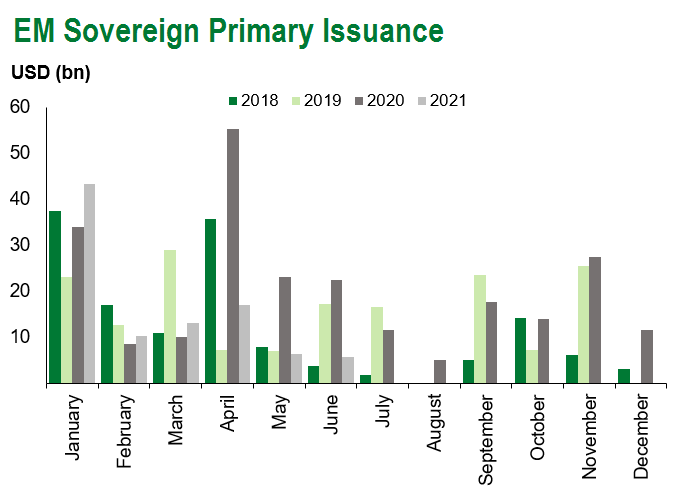
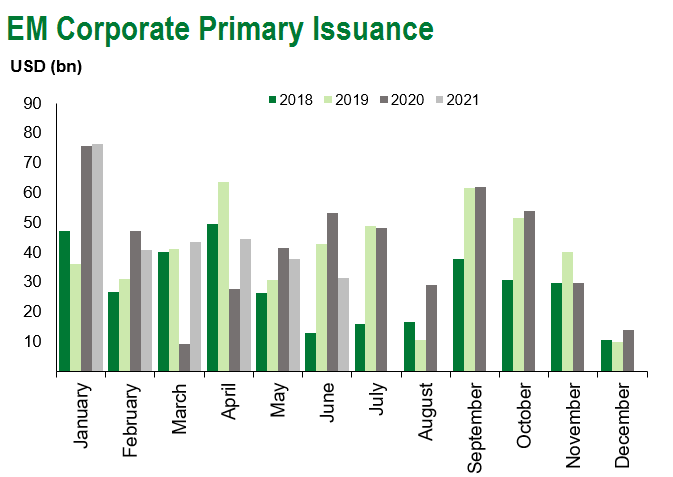
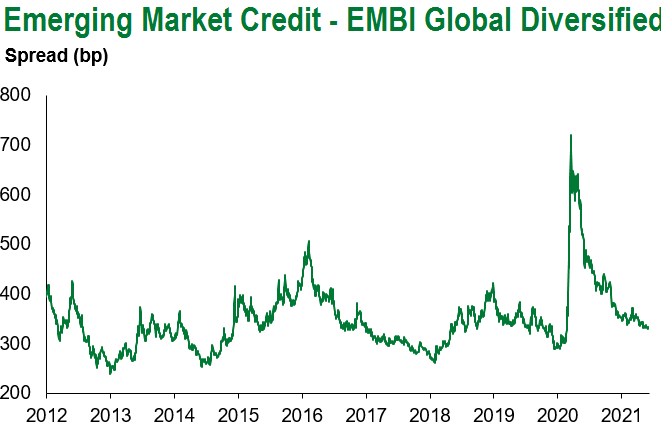

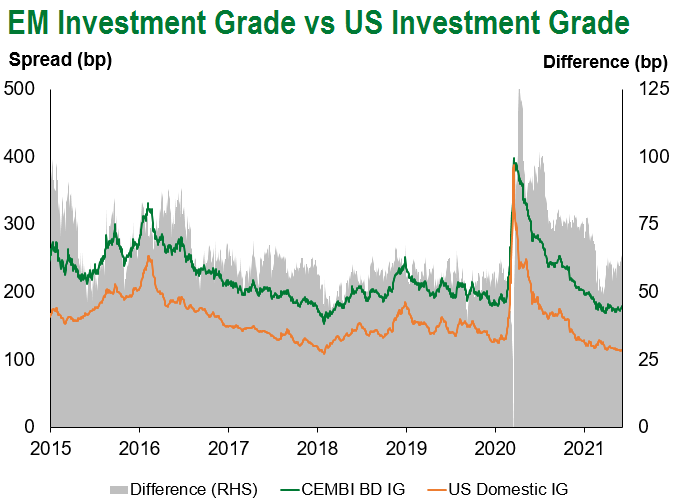
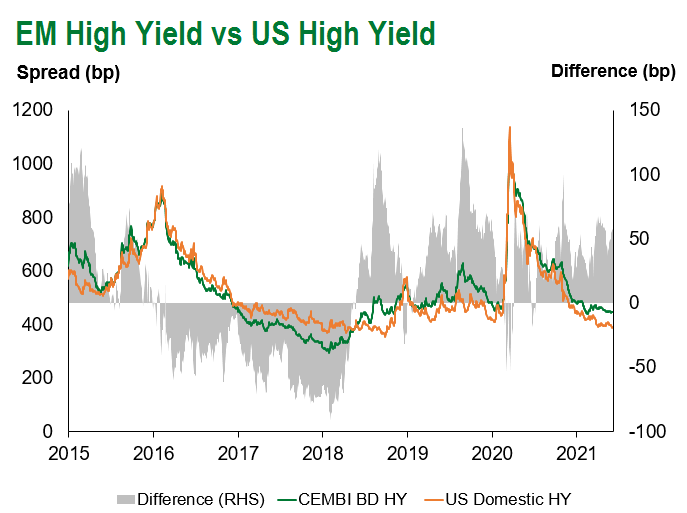
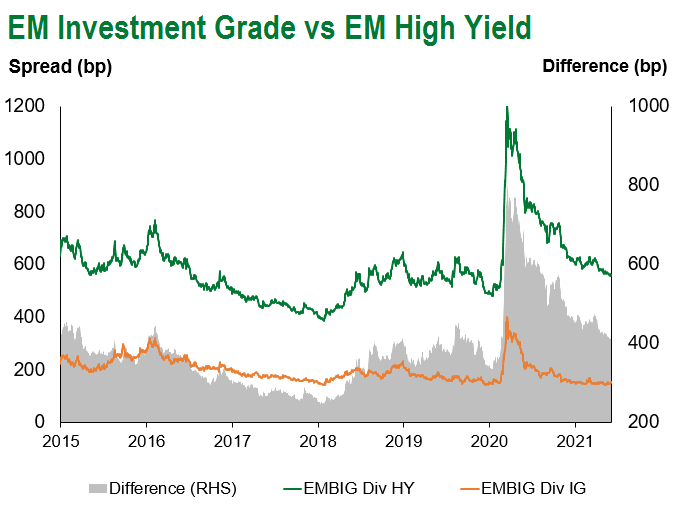
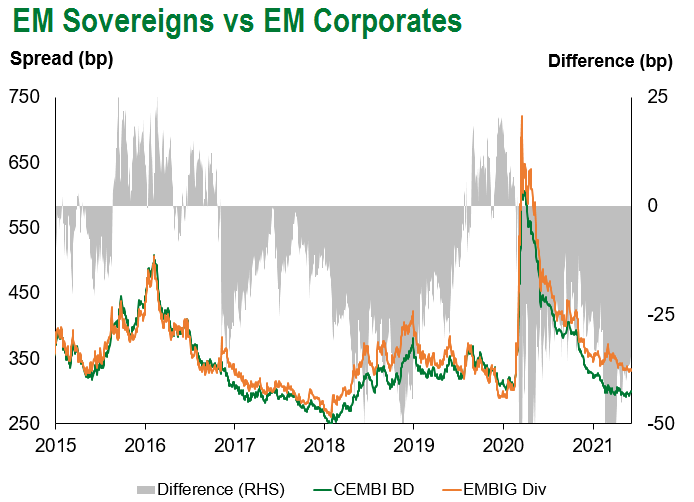
Emerging Markets Flows
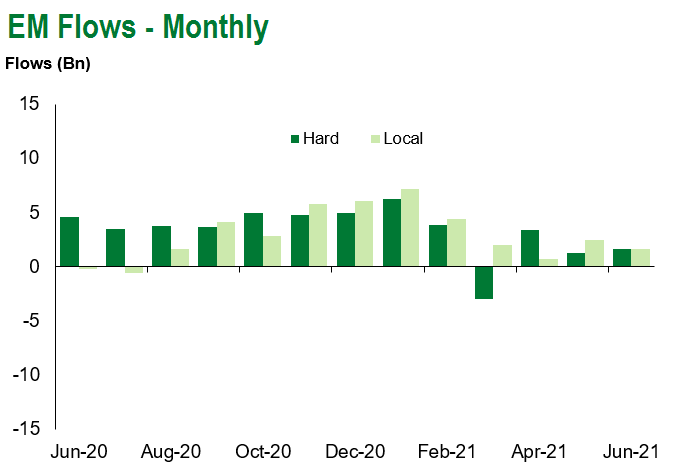
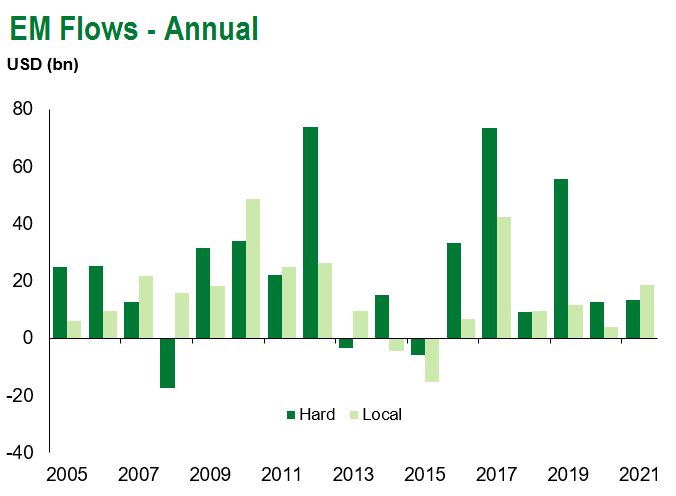
Source for graphs: Bloomberg, JPMorgan, Gramercy. As of June 11, 2021.
COVID Resources
Emerging Markets COVID-19 Case Summary
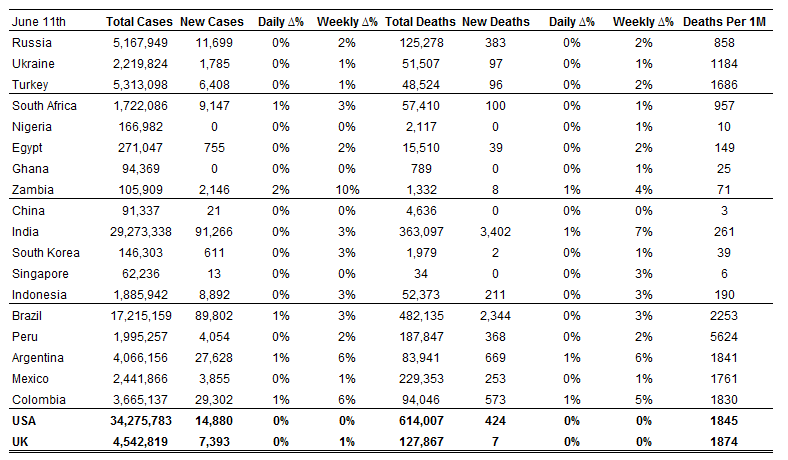
Source: Worldometer as of June 11, 2021.
Additional Crisis Resources:
Johns Hopkins COVID-19 Case Tracker
For questions, please contact:
Kathryn Exum, Senior Vice President, Sovereign Research Analyst, [email protected]
Petar Atanasov, Senior Vice President, Sovereign Research Analyst, [email protected]
Tolu Alamutu, CFA, Senior Vice President, Corporate Research Analyst, [email protected]
James Barry, Vice President, Corporate Research Analyst, [email protected]
This document is for informational purposes only. The information presented is not intended to be relied upon as a forecast, research or investment advice, and is not a recommendation, offer or solicitation to buy or sell any securities or to adopt any investment strategy. Gramercy may have current investment positions in the securities or sovereigns mentioned above. The information and opinions contained in this paper are as of the date of initial publication, derived from proprietary and nonproprietary sources deemed by Gramercy to be reliable, are not necessarily all-inclusive and are not guaranteed as to accuracy. This paper may contain “forward-looking” information that is not purely historical in nature. Such information may include, among other things, projections and forecasts. There is no guarantee that any forecasts made will come to pass. Reliance upon information in this paper is at the sole discretion of the reader. You should not rely on this presentation as the basis upon which to make an investment decision. Investment involves risk. There can be no assurance that investment objectives will be achieved. Investors must be prepared to bear the risk of a total loss of their investment. These risks are often heightened for investments in emerging/developing markets or smaller capital markets. International investing involves risks, including risks related to foreign currency, limited liquidity, less government regulation, and the possibility of substantial volatility due to adverse political, economic or other developments. The information provided herein is neither tax nor legal advice. Investors should speak to their tax professional for specific information regarding their tax situation.